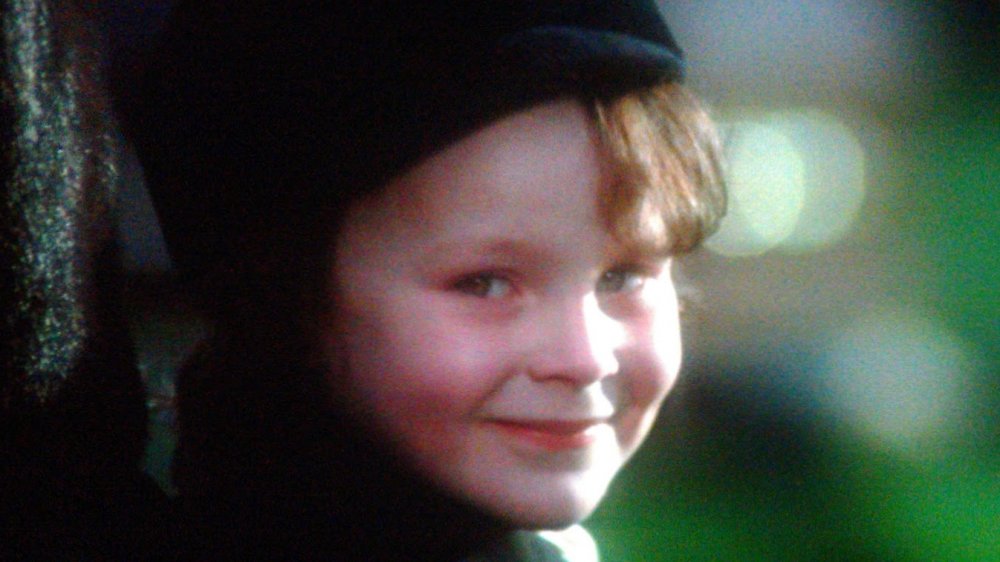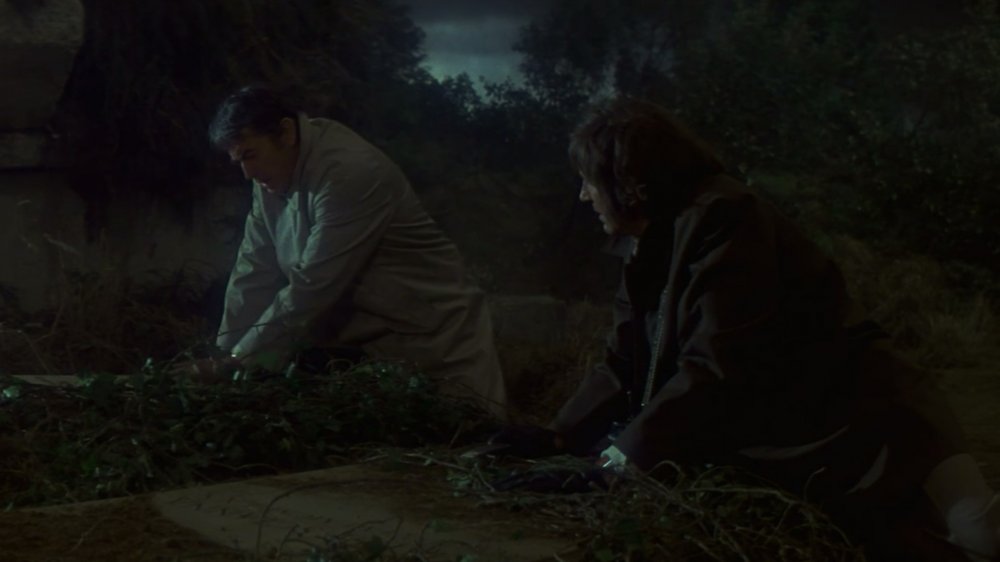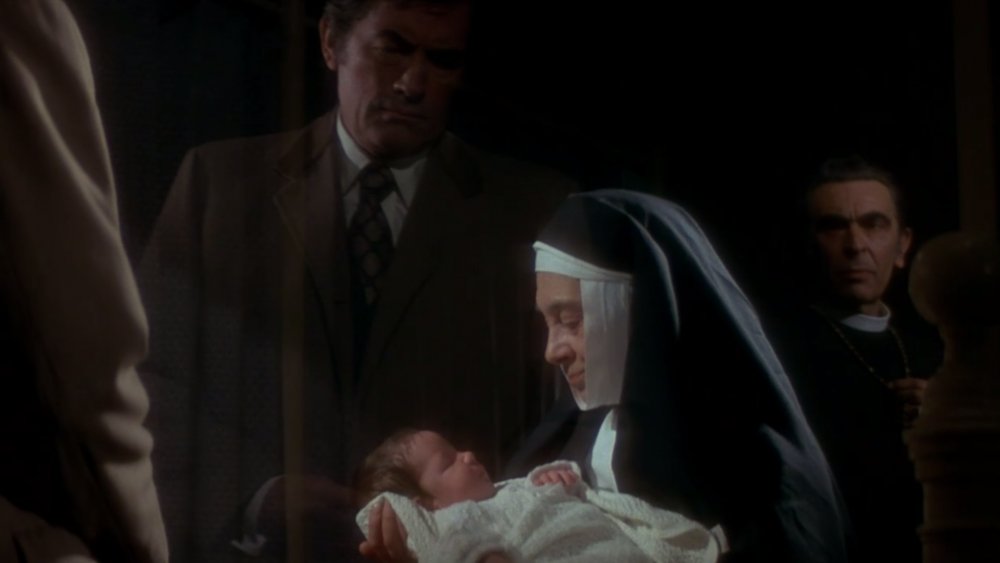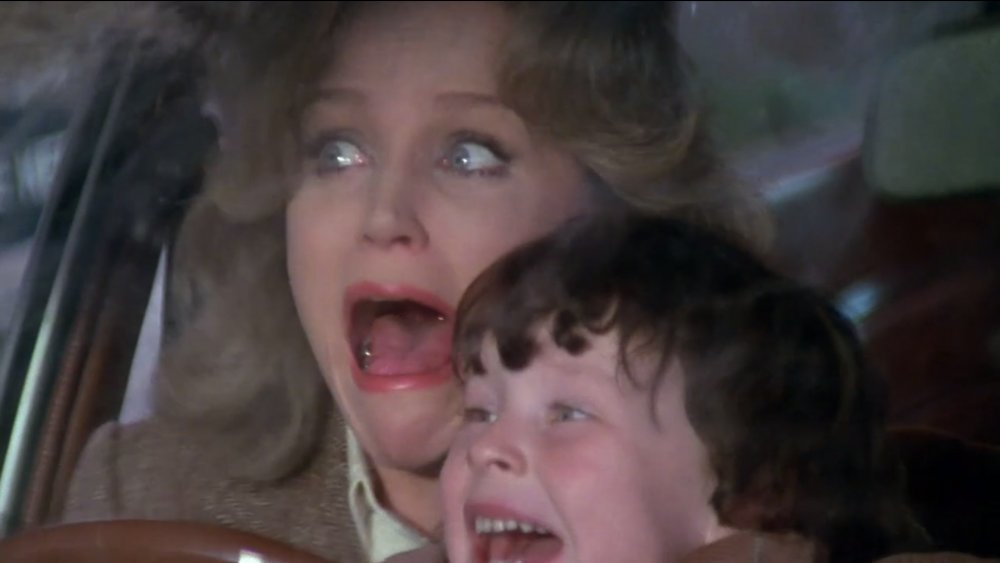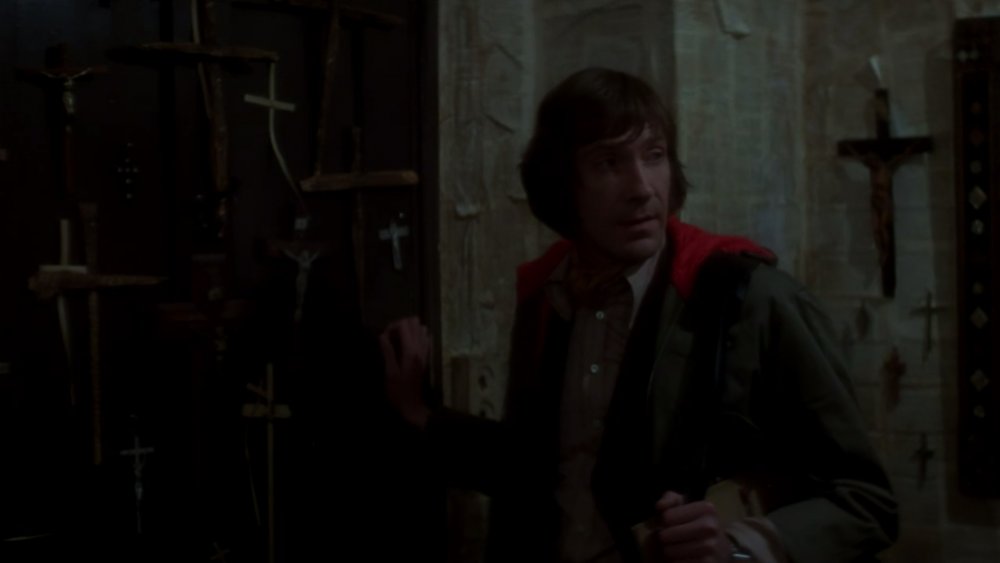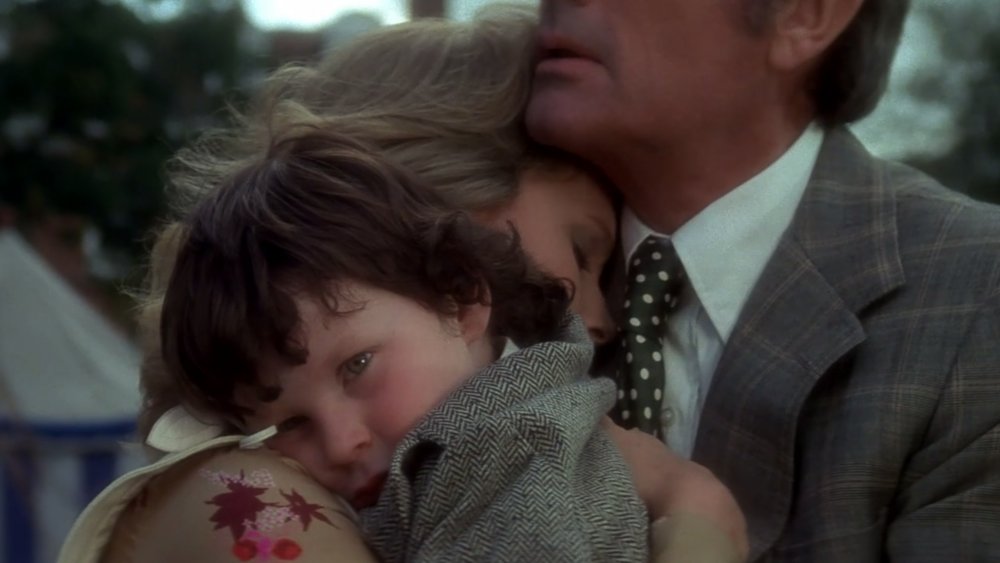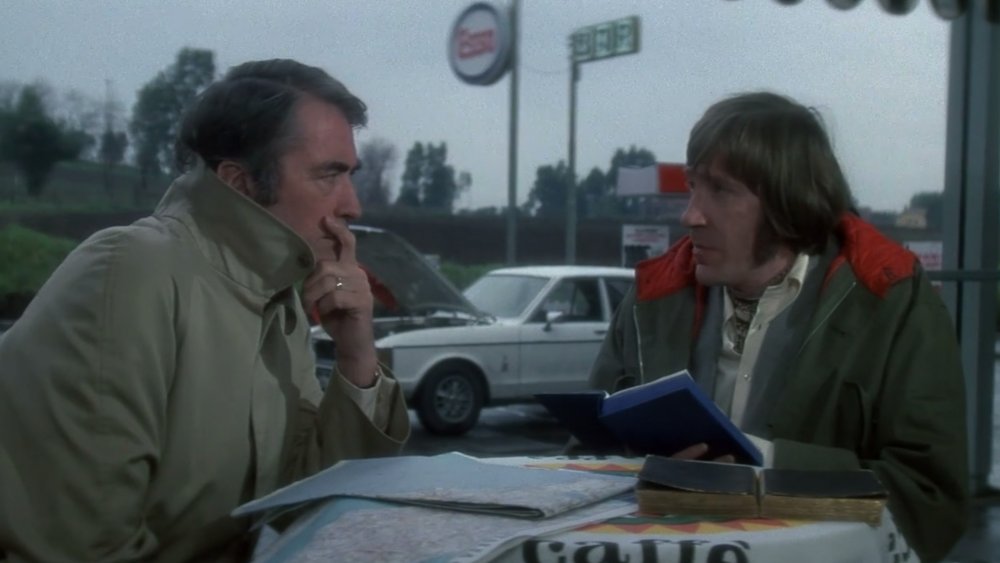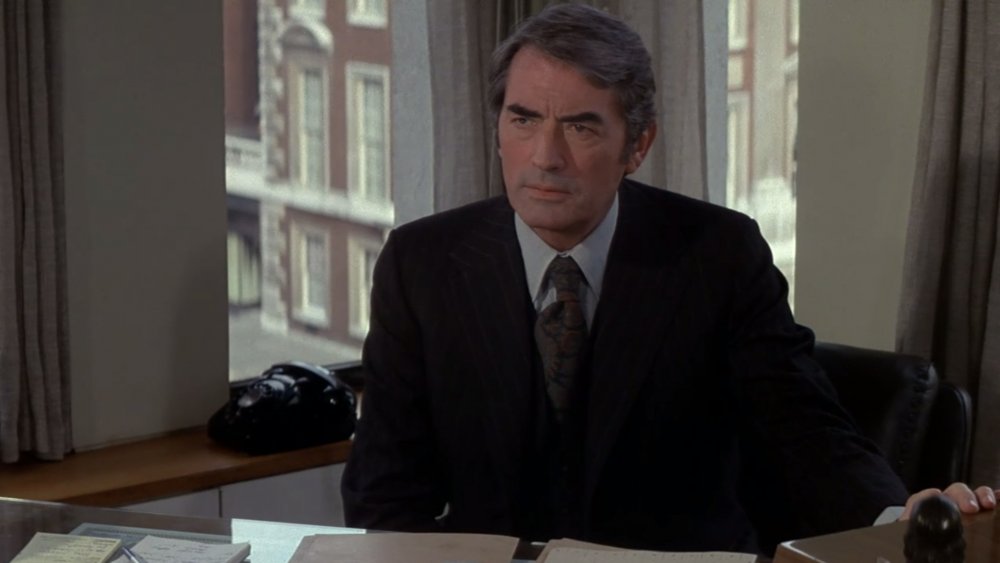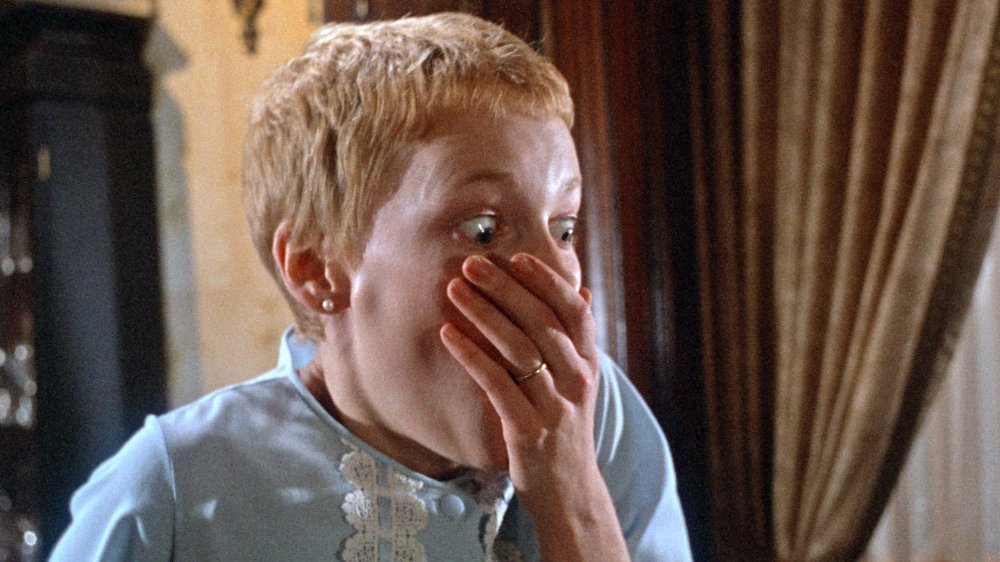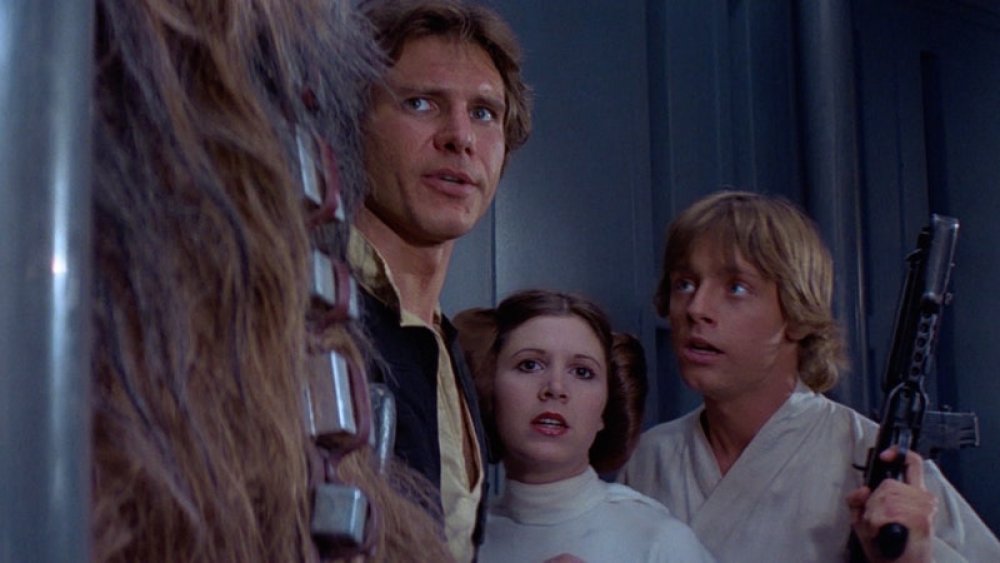The Untold Truth Of The Omen
Released in 1976, The Omen is one of the most renowned occult films of all time. The chilling tale of Damien (Harvey Spencer Stephens), the son of the devil, has continued to thrill and terrify audiences to this day while going on to become quite a successful franchise, with sequels, a remake, a TV series, and even novels. It's also pretty much ruined the name "Damien" for parents everywhere.
Creating a hit with a lasting legacy like The Omen is no small feat. Whether it was struggling to find a studio, acquiring the perfect cast, or potentially combating real evil spirits, the cast and crew certainly had their work cut out for them. But the secrets behind The Omen don't need to be deciphered from cryptic biblical poems. You can find them all right here. From behind-the-scenes deaths to the film's lasting impact, here's the untold truth of one of the all-time great horror movies.
The script for The Omen was unpopular with studios
Though The Omen is now regarded as one of the most successful supernatural horror films of all time, in its infancy, the film struggled to gain the attention of studios precisely because of its more overt horror elements.
As The Omen's director, Richard Donner, explained to Movies in Focus, "The thing is, The Omen had been around for a long time. It was called The Antichrist and eventually every studio in town turned it down. When I read it, the reason I thought they turned it down was because it was a horror film and if they turned it into what I believed was a mystery-suspense-thriller and got rid of the cheesy cloven hoofs and devils, that maybe it would have a chance."
Alan Ladd Jr., the prestigious head of Fox Studios at the time, agreed that the film would probably fare better if it was marketed as a thriller instead of a typical horror movie with jump scares or excessive violence. And fortunately for Donner, Ladd decided to pick up the project under the condition that The Omen change gears and style itself more in line with a mystery-suspense film. Of course, Donner took the deal, and The Omen finally found its footing and gained more credibility among filmgoers reluctant to see a full-on horror flick.
A small budget and a big payoff
Though The Omen features some excellent practical effects and on-scene locations, the film was restricted to a relatively small budget considering everything that needed to go into the making of the film. When talking to IGN about the movie, Richard Donner said he had to "deliver the picture for $2 million, including salaries."
Considering that many of the scenes required on-location shoots in England, Italy, and Israel, the cost of travel certainly wasn't cheap and ultimately inflated the film's expenses. Additionally, securing the talent, like Gregory Peck and Lee Remick, further put a dent in the film's budget. Perhaps the most notable cost was getting composer Jerry Goldsmith on board to create the film's now-infamous score. Donner was so determined to have Goldsmith on the project that Alan Ladd Jr. eventually put up $25,000 to acquire Goldsmith's talents.
With all of these costs, the pressure to successfully deliver The Omen was a significant stressor for Donner. "It was constantly on my head. I was scared, and I didn't want to disappoint Alan Ladd, who had trusted me," the director told IGN. However, the high costs and hard work would ultimately pay off for Donner and the film's crew. The Omen made over $60 million at the box office, making back well over its $2 million budget.
Lee Remick's reaction to the baboons was real
One of the film's most terrifying moments is undoubtedly the baboon scene. When Lee Remick's character, Katherine, takes Damien to a zoo, all of the animals begin to act rather strangely in the child's presence. Most of the creatures desperately try to get some distance between themselves and Damien ... that is, except for the baboons. As Katherine and Damien ride along in a car through the baboon exhibit, the monkeys begin to act aggressively, jumping on the vehicle and screeching at the pair. Katherine is understandably horrified and grabs onto her child as the baboons continue to surround the car and pound on the windows. Unfortunately for Lee Remick, her unbridled horror in this scene was very real, as she was actually terrified by the situation unfolding around her.
As producer Mace Neufeld told IGN, "She didn't say she couldn't drive a shift car, but she had the car and drove it and stalled it just as the animals were let loose." Evidently, Remick didn't know how to get the car moving again, and as the baboons swarmed the vehicle, she began to freak out. "When you look at her through that windshield," Neufeld said, "she was terrified." It probably didn't help matters any that these primates were especially ticked off. According to an interview with director Richard Donner, the baboons hadn't been fed in a while. On top of that, the filmmakers had placed two baby baboons (with a trainer) inside the car to aggravate the animals outside. So yeah, the baboons really were attacking the car. Hopefully, Lee Remick wasn't as traumatized by the incident as her character Katherine was.
The production of The Omen may have been cursed
Similar to the reputation of other occult films like The Exorcist, The Omen's production was plagued by a series of strange coincidences and tragedies that sparked rumors about the film's production being cursed.
For example, The Omen is a clear example of catching lightning in a bottle, but perhaps that's because literal lightning kept striking the cast and crew. When Gregory Peck was flying to London, his plane was struck by lightning. Alone, this occurrence isn't anything too remarkable. However, a few weeks later, the film's executive producer, Mace Neufeld, was also on a flight to Los Angeles that was struck by lightning. While these two incidents are a bit eerie, what makes things even stranger is that Harvey Bernhard, another producer, had a close call with lightning while working on the film while shooting in Rome.
Unfortunately, not everyone came out of the filming unscathed. John Richardson, the special effects artist responsible for creating the film's iconic decapitation scene, was in a head-on collision. Though Richardson survived, his assistant, Liz Moore, was decapitated, mirroring the scene from the film. Another crew member, the animal trainer who worked on the film's baboon scene, was mauled and killed by a tiger the day after the sequence had been completed. Additionally, a plane meant to be used for filming that was switched out last minute later crashed and killed all the passengers on board.
Damien was cast after unleashing an unholy terror
The role of Damien was likely the most critical and riskiest casting decision for the entire film. Gregory Peck had turned in an Oscar-winning performance as Atticus Finch in To Kill a Mockingbird in 1962, and Lee Remick had wowed audiences in Anatomy of a Murder in 1959. These established actors were safe bets to deliver great performances, but the child who would play Damien wouldn't have had so long to establish themselves in Hollywood.
Damien needed to be believable as the literal child of Satan, so the filmmakers knew they had to pick a fierce and convincing kid. As a result, they devised an audition where children were told to attack the filmmakers to prove their mettle. And when Harvey Spencer Stephens struck Richard Donner, the boy didn't hold back. As producer Harvey Bernhard described the audition to IGN, "Dick [Donner] says, 'When I yell action, you attack me, and don't stop until I yell cut.' Dick yells action, the guy hits him right in the balls ... boom boom boom boom. And Dick says, 'Cut,' and the kid doesn't quit. Dick says, 'Dye his hair black, and he is Damien.'"
So after his virtuoso audition, the young actor had his blonde hair dyed a darker shade, and he was given contacts to alter the color of his eyes. Of course, he didn't need any help channeling Damien's aggression. Considering the film's success, Stephens was definitely the right choice for the role. Hopefully, Richard Donner thinks Harvey's performance is worth the pain he endured during the audition process.
The Book of Revelation poem isn't actually in the Bible
Throughout the film, Ambassador Robert Thorn (Peck) and photographer Keith Jennings (David Warner) work together to uncover the truth behind Thorn's son and the terrible occurrences taking place around him, all with the help of a poem from the Book of Revelation. Supposedly, the cryptic poem foretells the coming of the Antichrist and holds the key to defeating Damien.
Despite the importance of this poem in the film, fans may be surprised to learn it isn't actually in the Bible at all. In an interview with Den of Geek, screenwriter David Seltzer admitted, "I got in trouble with a lot of people for that. ... I mean all of the prophesizing was real and true and accurate and taken from the Bible."
Though the poem isn't actually in the Book of Revelation, Seltzer does note that he drew influence from the source material when crafting the poem, "The eternal sea, as a matter of fact, was what grabbed me when I was looking for some way to do a story about the devil, the unholy. There was a passage in Revelation that said, 'The beast will rise from the eternal sea.' ... And then I found, 'Let he who hath wisdom reckon the number of the beast, and the number is 666,' and I basically turned that into a calendar date for when he would be come to Earth." So even though the words didn't come from Revelation, the inspiration certainly did.
The studio was reluctant to cast Gregory Peck in The Omen
Gregory Peck is probably most celebrated for his stellar performance as Atticus Finch in the 1962 adaption of To Kill a Mockingbird. However, the actor had a long and fruitful Hollywood career spanning decades, with performances in films such as Roman Holiday, Cape Fear, and The Big Country. So it might be a bit of a surprise that he wasn't the #1 pick for the part of Ambassador Robert Thorn.
When searching for talent to take on the role of Thorn, several actors such as Charlton Heston, William Holden, and Roy Scheider had already passed on the role. True, Gregory Peck was an obvious choice for the part, but the studio was reluctant to reach out to the actor because Peck had suffered a family tragedy. Peck's son, Jonathan, had recently died by suicide, so the studio wasn't sure if Peck would be ready to take on any acting gigs. However, after reaching out to Peck's agent, the studio got permission to forward the script to Peck, who quickly signed onto the project. Screenwriter David Seltzer says, "I think there may have been some connection in his exorcising his own sense of ... I lost a kid, and when you lose a child, there's no way not to feel at fault."
Gregory Peck's involvement with the picture certainly helped to elevate the film in the public's perception. According to Alan Ladd Jr., "Putting Gregory Peck and Lee Remick in it, you're saying to people right off the bat this is not a normal horror picture. It was scary, but it was classy scary." Without Gregory Peck at the helm, it's likely The Omen wouldn't have gotten its sophisticated reputation.
The film was largely influenced by other occult classics
By the time The Omen was released in 1976, occult movieswere rising in popularity, so much so that the genre was becoming saturated with obscure, satanic-themed films. The genre's growing popularity was largely due to gems like Rosemary's Baby. The 1968 classic told the story of a pregnant woman who might be carrying the spawn of Satan, and it helped cement the occult genre into pop culture.
Apparently, screenwriter David Seltzer was similarly impacted by the film. He told the Canadian magazine Rue Morgue (via BFI) in 2015, "I had been influenced by Rosemary's Baby, and I hadn't even realized it until people started making comparisons." However, Rosemary's Baby wasn't the only film that had an impact on The Omen. According to Seltzer, "Certainly, it was impacted by The Exorcist." The Exorcist is regarded by many as one of the greatest horror movies ever made, and its tale of a possessed girl was 100% responsible for the rise of spiritually scary horror films.
And when looking at these three films, the similarities are fairly evident. For instance, all three feature-heavy Catholic themes, specifically regarding Satan and the concept of good versus evil. Each film focuses on children and either the possession or subversion of the innocence that's often associated with children.
The studio demanded a new ending
The final shot of Damien ominously smiling back at the camera is one of the most chilling moments in The Omen and one of the greatest endings in horror history. However, this wasn't always how the final scene was going to play out. According to the director's commentary, in the initial cut, Damien was supposed to have died, and his casket would've been shown alongside his parent's coffins. After screening the film to studio executives, Alan Ladd Jr. asked if there was a way to change the scene so that Damien would live in the end.
To accommodate the studio's request, Richard Donner added the film's funeral scene, which revealed that Damien survived. In his commentary, Donner describes how how he got that final shot of Damien, saying, "The kid turned to the camera, and I said, 'Don't you dare smile. ... If you smile, I'll never talk to you.' And he fought the smile, then he smiled, and it was magic."
It's safe to say that Ladd's instincts were correct, and changing the ending scene was probably for the best. And considering the box office numbers, it seems like Damien's creepy little smile was worth tens of millions.
The Omen helped Star Wars get made
Not only did The Omen impact the legacy of horror films, but its success helped to get another popular film franchise off its feet. When talking with Scraps from the Loft about his 1995 film Assassins, Richard Donner dropped an interesting tidbit about what happened with the profits made by The Omen. According to Donner, "When we made The Omen, that money Alan Ladd was able to spend at Fox to do Star Wars. So you feel good about that. Not only is your picture a success, but it helps other people too."
As was chronicled in the documentary Laddie: The Man Behind the Movies, Alan Ladd Jr. was instrumental in fiercely negotiating with Fox for George Lucas' creative freedoms in making Star Wars in 1977. Having read the script of the film, Ladd believed in the abilities of Lucas and knew he could make a hit for the ages. In other words, after taking a chance on The Omen, its success paved the way for Ladd to put his career on the line for Lucas and his space opera. So next time you see Darth Vader, be sure to give a little thanks to Damien.
